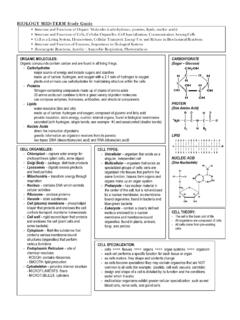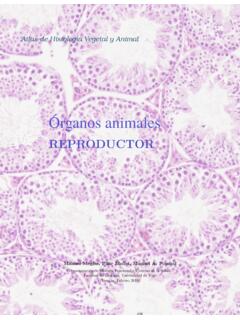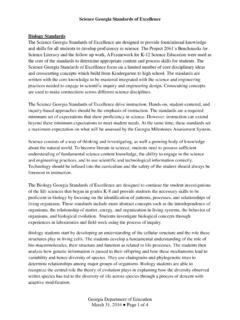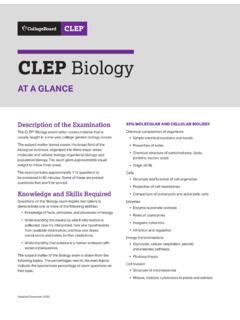Transcription of DIVERSIFIED HEALTH OCCUPATIONS
1 DIVERSIFIEDHEALTHOCCUPATIONSS eventh EditionLouise Simmers, MEd, RNKaren Simmers-Nartker, BSN, RNSharon Simmers-Kobelak, BBAA ustralia Brazil Japan Korea Mexico Singapore Spain United Kingdom United i1/31/08 12:29:47 PM1/31/08 12:29:47 PMCopyright 2009 Cengage Learning, Inc. All Rights Reserved. May not be copied, scanned, or duplicated, in whole or in ed HEALTH OCCUPATIONS , Seventh EditionLouise SimmersKaren Simmers-NartkerSharon Simmers-KobelakVice President, Career and Professional Editorial: Dave GarzaDirector of Learning Solutions: Matthew KaneManaging Editor: Marah BellegardeAcquisitions Editor: Matthew SeeleySenior Product Manager: Juliet SteinerEditorial Assistant: Megan TarquinioVice President, Marketing, Career and Professional: Jennifer McAveyMarketing Manager: Michele McTigheTechnology Project Manager: Ben KnappProduction Director: Carolyn MillerSenior Art Director: Jack PendletonContent Project Manager.
2 Anne Sherman 2009 Delmar, Cengage LearningALL RIGHTS RESERVED. No part of this work covered by the copyright herein may be reproduced, transmitted, stored, or used in any form or by any means, graphic, electronic, or mechanical, including but not limited to photocopying, recording, scanning, digitizing, taping, Web distribution, information networks, or information storage and retrieval systems, except as permitted under Section 107 or 108 of the 1976 United States Copyright Act, without the prior written permission of the product information and technology assistance, contact us atCengage Learning Academic Resource Center, 1-800-423-0563 For permission to use material from this text or product.
3 Submit all requests online at permissions questions can be emailed to and ExamView Pro are registered trademarks of FSCreations, Inc. Windows is a registered trademark of the Microsoft Corporation used herein under license. Macintosh and Power Macintosh are registered trademarks of Apple Computer, Inc. Used herein under license. 2009 Cengage Learning. All Rights Reserved. Cengage Learning WebTutor is a trademark of Cengage Learning. Library of Congress Control Number: 2007941692 ISBN-13: 978-1-4180-3021-6 ISBN-10: 1-4180-3021-XDelmar Cengage Learning5 Maxwell DriveClifton Park, NY 12065-2919 USAC engage Learning products are represented in Canada by Nelson Education, your lifelong learning solutions, visit our corporate website at in Canada1 2 3 4 5 6 7 12 11 10 09 08 Notice to the ReaderPublisher does not warrant or guarantee any of the products described herein or perform any independent analysis in connection with any of the product information contained herein.
4 Publisher does not assume, and expressly disclaims, any obligation to obtain and include information other than that provided to it by the manufacturer. The reader is expressly warned to consider and adopt all safety precautions that might be indicated by the activities described herein and to avoid all potential hazards. By following the instructions contained herein, the reader willingly assumes all risks in connection with such instructions. The publisher makes no representations or warranties of any kind, including but not limited to, the warranties of fi tness for particular purpose or merchantability, nor are any such representations implied with respect to the material set forth herein, and the publisher takes no responsibility with respect to such material.
5 The publisher shall not be liable for any special, consequential, or exemplary damages resulting, in whole or part, from the readers use of, or reliance upon, this ii2/1/08 1:54:56 PM2/1/08 1:54:56 PMCopyright 2009 Cengage Learning, Inc. All Rights Reserved. May not be copied, scanned, or duplicated, in whole or in 7 Anatomy and PhysiologyObserve Standard PrecautionsInstructor s Check Call Instructor at This PointSafety Proceed with CautionOBRA Requirement Based on Federal LawMath SkillLegal ResponsibilityScience SkillCareer InformationCommunications SkillTechnologyChapter ObjectivesAfter completing this chapter, you should be able to: Apply the appropriate terminology to major organs and systems of the human body Identify the major functions of each body system Compare interrelationships of body systems Describe basic diseases affecting each of the body systems Defi ne, pronounce, and spell all key termsNOTE.
6 This chapter is meant to serve as a brief introduction to anatomy and physiology. For more detailed information, refer to the references listed in the bibliography at the back of the 1401/17/08 12:19:56 PM1/17/08 12:19:56 PMCopyright 2009 Cengage Learning, Inc. All Rights Reserved. May not be copied, scanned, or duplicated, in whole or in and PhysiologyKEY TERMS anatomycellcell membranecentrosome (sen -troh-sohm)chromatin (crow -ma-tin)connective tissuecytoplasm (sy -toe-plaz-um)dehydrationedema (eh-dee -mah)endoplasmic reticulum (en -doe-plaz-mik re-tik -you-lum)epithelial tissue (ep -eh-thiel -e-al tish -u)genesgenomeGolgi apparatus (gawl -jee ap-a-rat -us)lysosomes (ly -sah-soms)meiosis (my-o -sis)mitochondria (my-toe-con -dree-ah) mitosis (my-toe -sis)muscle tissuenerve tissuenucleolus (new -klee-oh -lus)nucleusorganorganellespathophysiolo gyphysiology (fi zz-ee-all -oh-gee)pinocytic vesiclesprotoplasm (pro -toe-plaz-um)
7 Stem cellssystemtissuevacuoles7:1 Basic Structure of the Human BodyObjectivesAfter completing this section, you should be able to: Label a diagram of the main parts of a cell Describe the basic function of each part of a cell Compare the four main types of tissue by describing the basic function of each type Explain the relationships among cells, tissues, organs, and systems Defi ne, pronounce, and spell all key terms7:1 INFORMATIONThe human body is often described as an effi -cient, organized machine. When this machine does not function correctly, disease occurs. Before NOTE: A basic knowledge of human anatomy and physiology is essential for almost every HEALTH care provider.
8 However, some HEALTH careers are related to specifi c body systems. As each body system is discussed, examples of related HEALTH careers are listed. The following HEALTH career categories require knowledge of the structure and function of the entire human body and will not be listed in specifi c body system HEALTH CAREERS Athletic Trainer Emergency Medical Careers Medical Laboratory Careers Medical Assistant Medical Illustrator Nursing Careers Pharmacy Careers Physician Assistant Physician Surgical 1411/17/08 12:20:07 PM1/17/08 12:20:07 PMCopyright 2009 Cengage Learning, Inc. All Rights Reserved. May not be copied, scanned, or duplicated, in whole or in 7142understanding the disease processes, however, the HEALTH worker must fi rst understand the nor-mal functioning of the body.
9 A basic understand-ing of anatomy and physiology is therefore necessary. Anatomy is the study of the form and structure of an organism. Physiology is the study of the processes of living organisms, or why and how they work. Pathophysiology is the study of how disease occurs and the responses of living organisms to disease basic substance of all life is protoplasm. This material makes up all living things. Although protoplasm is composed of ordinary elements such as carbon, oxygen, hydrogen, sulfur, nitro-gen, and phosphorus, scientists are unable to combine such elements to create that character-istic called forms the basic unit of structure and function in all living things: the cell.
10 Cells are microscopic structures that carry on all the func-tions of life. They take in food and oxygen; pro-duce heat and energy; move and adapt to their environment; eliminate wastes; perform special functions; and reproduce to create new, identical cells. The human body contains trillions of cells. These cells vary in shape and size, and perform many different cells have the following basic parts (fi g-ure 7-1): Cell membrane: the outer protective cover-ing of the cell. It is also called the plasma membrane or plasmalemma. It is semiperme-able; that is, it allows certain substances to enter and leave the cell while preventing the passage of other substances.


![Class - XII Multiple Choice Question Bank [MCQ ] Term I](/cache/preview/c/9/8/8/1/a/2/8/thumb-c9881a28c229f817f59fa2c1b29649a9.jpg)






